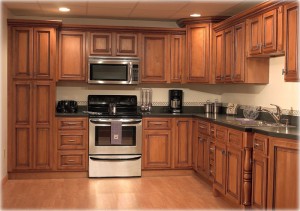
Refinishing cabinets
This is part one of a four part series covering the following:
1) Existing cabinet materials
2) Method of refinishing
3) Selecting a Contractor
4) Doing the work yourself
When refinishing kitchen or bathroom cabinets it is important to understand the type of materials the cabinets are built from. The existing cabinet materials and their condition will greatly determine the outcome and ‘look’ of the refinishing.
Cabinets are constructed from a large variety of materials. Some employ high quality solid hardwoods for doors and drawer fronts. Others utilize composite materials, veneers, and artificial wood laminates. Typically, cabinet boxes are constructed of veneered plywood, or lesser quality materials such as particleboard, or other pulp and paper composites.
Hardwoods such as Cherry, Ash, Walnut, and Oak are commonly used for doors and drawer fronts on most ‘high quality’ cabinets. Softer woods such as Birch, Pine, along with a variety of wooden veneers are used on lesser grade cabinets. Composite materials and paper veneers are commonly used on the least expensive cabinetry. A good ‘Rule of Thumb’ is that the better quality the cabinets are to begin with, the better chances for a great refinishing outcome.
All woods tend to lend themselves ascetically to certain colors more successfully than others. Typically, the darker the wood, the less likely it can be refinished to a lighter color. Where as lighter woods will easily accept darker stain and pigment. Also, some woods types have either a ‘Surface Grain’ or an ‘Open Grain’. Surface Grain, is generally dense and hard, and will flow along the surface of the wood in large wide bands. This type of grain tends to detour stains from adhering. Instead, the stain will adhere to the soft cellulose between the bands of grain, leaving a tiger stripped effect. Open Grain is when the grain of the wood is openly exposed, like small cracks or pockets on the wood surface. Here the grain of the wood is porous, and will except more color pigment than the surrounding wood surface, creating a specked more leopard effect. Oak and Ash are notorious for potential refinishing problems due to Open Grain. Walnut, Cherry, and Pine are equally difficult to work with because of Surface Grain. It is very important to understand the natural make-up of the wood in order to anticipate the desired refinishing result.
As mentioned, most doors and drawer fronts will be solid wood, but what about of the cabinet boxes themselves? Since almost all cabinet boxes (excluding ‘high end’ cabinetry) are built of plywood with veneer surfaces, be aware that this material accepts stain much differently than solid wood. The reason being, that veneer is typically paper thin sheaths of wood, glued down to an indifferent wood surface. The glue under the veneer blocks the stain or pigment from saturating deep enough to maintain its color integrity. This is why when staining cabinets, the doors and drawer fronts will appear richer in color than the cabinet boxes, often creating an unwanted ‘two-tone’ effect. This can be corrected so all the cabinet surfaces match in color depth, and tone; but requires a special technique often referred to as ‘Toning’, which will be discussed further under Method of Refinishing.
Find an expert contractor today at http://www.mylaborjob.com/find



 Auto insurance quote
Auto insurance quote Get a Business Loan
Get a Business Loan